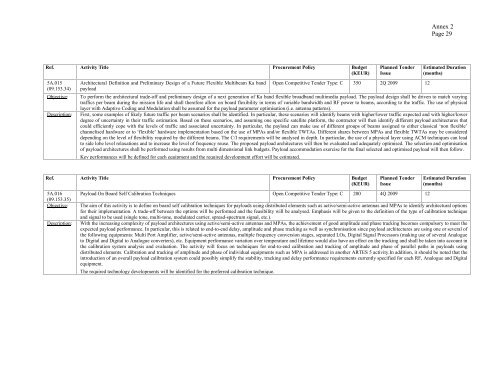ARTES-5.1 â ESA Telecom Technology Workplan ... - Emits - ESA
ARTES-5.1 â ESA Telecom Technology Workplan ... - Emits - ESA
ARTES-5.1 â ESA Telecom Technology Workplan ... - Emits - ESA
- No tags were found...
You also want an ePaper? Increase the reach of your titles
YUMPU automatically turns print PDFs into web optimized ePapers that Google loves.
Annex 2Page 29Ref. Activity Title Procurement Policy Budget(KEUR)5A.015(09.153.34)Objective:Description:Architectural Definition and Preliminary Design of a Future Flexible Multibeam Ka bandpayloadPlanned TenderIssueOpen Competitive Tender Type: C 350 2Q 2009 12Estimated Duration(months)To perform the architectural trade-off and preliminary design of a next generation of Ka band flexible broadband multimedia payload. The payload design shall be driven to match varyingtraffics per beam during the mission life and shall therefore allow on board flexibility in terms of variable bandwidth and RF power to beams, according to the traffic. The use of physicallayer with Adaptive Coding and Modulation shall be assumed for the payload parameter optimisation (i.e. antenna patterns).First, some examples of likely future traffic per beam scenarios shall be identified. In particular, these scenarios will identify beams with higher/lower traffic expected and with higher/lowerdegree of uncertainty in their traffic estimation. Based on these scenarios, and assuming one specific satellite platform, the contractor will then identify different payload architectures thatcould efficiently cope with the levels of traffic and associated uncertainty. In particular, the payload can make use of different groups of beams assigned to either classical ‘non flexible’channelised hardware or to ‘flexible’ hardware implementation based on the use of MPAs and/or flexible TWTAs. Different shares between MPAs and flexible TWTAs may be considereddepending on the level of flexibility required by the different beams. The C/I requirements will be analysed in depth. In particular, the use of a physical layer using ACM techniques can leadto side lobe level relaxations and to increase the level of frequency reuse. The proposed payload architectures will then be evaluated and adequately optimised. The selection and optimisationof payload architectures shall be performed using results from multi dimensional link budgets. Payload accommodation exercise for the final selected and optimised payload will then follow.Key performances will be defined for each equipment and the required development effort will be estimated.Ref. Activity Title Procurement Policy Budget(KEUR)5A.016(09.153.35)Objective:Description:Planned TenderIssuePayload On Board Self Calibration Techniques Open Competitive Tender Type: C 200 4Q 2009 12Estimated Duration(months)The aim of this activity is to define on board self calibration techniques for payloads using distributed elements such as active/semi-active antennas and MPAs to identify architectural optionsfor their implementation. A trade-off between the options will be performed and the feasibility will be analysed. Emphasis will be given to the definition of the type of calibration techniqueand signal to be used (single tone, multi-tone, modulated carrier, spread-spectrum signal, etc.).With the increasing complexity of payload architectures using active/semi-active antennas and MPAs, the achievement of good amplitude and phase tracking becomes compulsory to meet theexpected payload performance. In particular, this is related to end-to-end delay, amplitude and phase tracking as well as synchronisation since payload architectures are using one or several ofthe following equipments: Multi Port Amplifier, active/semi-active antennas, multiple frequency conversion stages, separated LOs, Digital Signal Processors (making use of several Analogueto Digital and Digital to Analogue converters), etc. Equipment performance variation over temperature and lifetime would also have an effect on the tracking and shall be taken into account inthe calibration system analysis and evaluation. The activity will focus on techniques for end-to-end calibration and tracking of amplitude and phase of parallel paths in payloads usingdistributed elements. Calibration and tracking of amplitude and phase of individual equipments such as MPA is addressed in another <strong>ARTES</strong> 5 activity.In addition, it should be noted that theintroduction of an overall payload calibration system could possibly simplify the stability, tracking and delay performance requirements currently specified for each RF, Analogue and Digitalequipment.The required technology developments will be identified for the preferred calibration technique.
















